Section 1 of the AP Calculus AB exam features MCQs and is split into 2 parts. Part A consists of 30 questions that you cannot use a calculator on. You have 1 hour to complete it. Part B consists of 15 questions that you can use a calculator on. You have 45 minutes for this section.
Section 1 accounts for 50% of the total points on the exam. Questions cover the 8 units of the AP Calculus AB course:
- Unit 1: Limits and Continuity
- Unit 2: Differentiation: Definition and Fundamental Properties
- Unit 3: Differentiation: Composite, Implicit, and Inverse Functions
- Unit 4: Contextual Applications of Differentiation
- Unit 5: Analytical Applications of Differentiation
- Unit 6: Integration and Accumulation of Change
- Unit 7: Differential Equations
- Unit 8: Applications of Integration
| Section I | Part A | Part B |
|---|---|---|
| No. of Questions | 30 MCQs | 15 MCQs |
| Exam Weight | 33.3% | 16.7% |
| Time Allotted | 1 hour | 45 minutes |
| Calculator Usage | Not Permitted | Permitted |
How to Approach AP Calculus AB Multiple-Choice Questions
Here are some tips for approaching the MCQ section of the AP Calculus AB exam:
Read the question and answer choices thoroughly.
Carefully read each question, then scan through the answer choices to see what form they will be in. For example, if a question includes an integral, the answer will be a number requiring you to calculate the result of the integral.
Underline important information.
When reading through the question stem, underline (or highlight when using UWorld AP Calc AB QBank Practice Tests) vocabulary, given values, function definitions, and actual quantities a question asks for. This will help you key in on the important aspects of the question. Analyze vocabulary words thoroughly. For example, if a question says “relative maximum,” think about what that means in terms of calculus, like “derivative equals 0 and changes sign from positive to negative,” and “second derivative is negative.”
Eliminate answer choices.
Cross out any answer choices that do not fit what the question is asking for. For example, if a question specifies that you’re looking for an x-value within a certain interval, you can eliminate choices that are outside that interval.
Keep moving.
If you do not immediately know how to solve a problem, skip it and come back later. The AP Calculus AB exam is timed, so answer the questions you know first. Mark questions you need to return to if there is time at the end of the exam.
Read the question again.
Before choosing an answer, reread the question to ensure you know what to calculate. For example, if you’re looking for the final value of a quantity f over an interval given an initial value of f and the derivative f ′, you’ll need to compute the definite integral of f ′. But don’t forget to add the initial value at the end. The results of intermediary steps are often answer choices but incorrect responses for the overall ask of the question, so be aware.
Answer every question.
On the AP Calculus AB exam, there is no difference between leaving a question blank and answering it incorrectly. So if you don’t know how to solve a problem, take a guess. You’ll have a 25% chance of getting it right. You can also try to eliminate a few answer choices to increase your odds of guessing correctly.
If you are running out of time, spend the last couple of minutes making sure you’ve filled in an answer for every question that you couldn’t get to.
AP Calculus AB Multiple-Choice Examples
Here are some examples of AP Calculus AB multiple-choice practice questions from the UWorld QBank that you may experience on the exam:.
This is the simplest type of question you’ll see where you are given an expression and asked to compute it. The challenge in this question is to notice that the form of the given limit matches the limit definition of the derivative from Unit 2, so identify the function (in this case, f(x) = 3x3 − 2x) and differentiate it.



- 0
- 3x3 - 2x
- 9x2 - 2
- -9x2 - 2
Below is a related rates question from Unit 4. There are a few things to note:
- There’s a word problem, so you’ll need to carefully read the question and pick out key information. For example, “water flows into the container at a constant rate of 8 cubic feet per minute” means that the volume of water is increasing by 8 ft3/min, or dVdt = 8.
- The College Board® sometimes gives geometric area and volume formulas in the question stem, so it’s not necessary to memorize anything more complicated than the area of a trapezoid.
- This is a calculator question on Part B, so answer choices are rounded to 3 decimal places. We advise that you use more than 3 decimal places in your calculations to eliminate round-off errors.


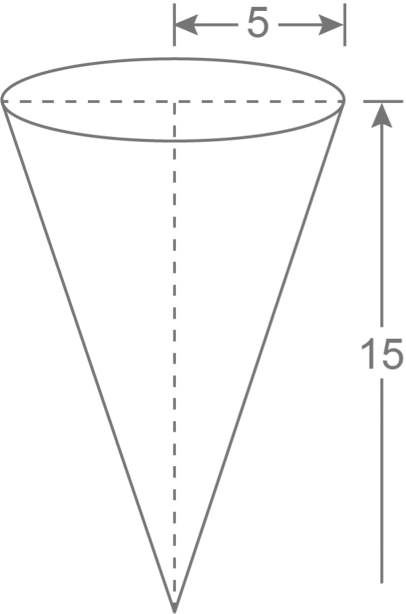
Water flows into a container in the shape of an open right circular cone, as shown above. The container has a radius of 5 feet at the top and its height is 15 feet. If water flows into the container at a constant rate of 8 cubic feet per minute, how fast in feet per minute is the water level rising when the height of the water is 9 feet? (The volume of a cone with radius r and height h is V = 1⁄3 πr 2h).
- 0.094
- 0.283
- 0.424
- 1.273
Here’s a question about limits in Unit 1. This question type gives 3 statements and asks which are true. There could be more than 1 statement that ends up being true, so it may be necessary to calculate multiple things. However, it’s sometimes possible to strategize. For example, in this particular question, Statement III is false. Knowing just this information, it is possible to eliminate answer choices A, C, and D. Therefore, you can confidently deduce that B is correct without testing statements I and II. It’s not always possible to strategize this way, but if you eliminate answer choices as you go, you may save yourself some work.


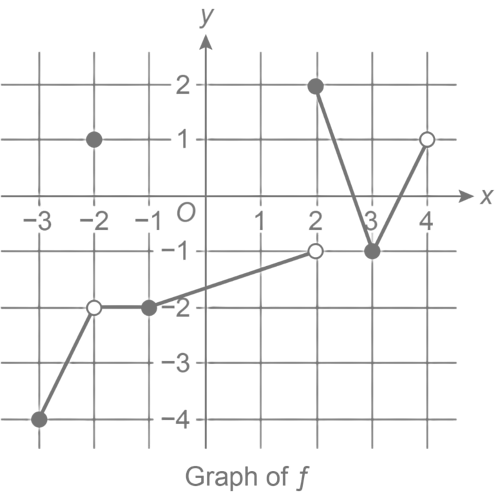
The figure above shows the graph of the function f. Which of the following statement(s) are true?
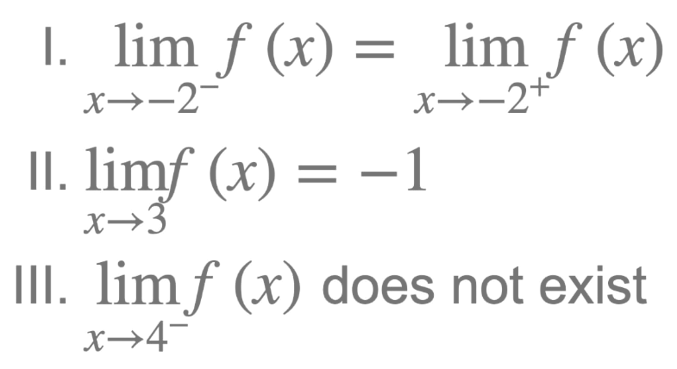
- III only
- I and II only
- I and III only
- I, II, and III
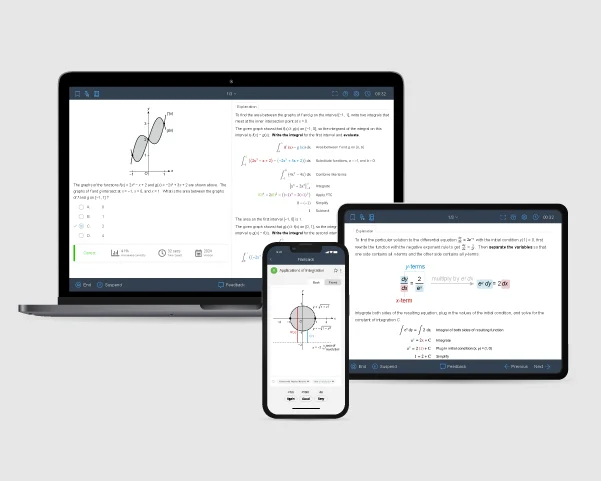
How Can I Practice AP Calculus AB Multiple-Choice Questions?
UWorld offers access to a QBank with questions that mimic the AP Calculus AB exam. Our in-depth answer explanations show you step by step how to solve the problems so you won’t see any curveballs on test day.
If you subscribe to UWorld AP Calc AB QBank, here are a few recommendations to get you started:
Learn the course material
If you are still learning AP Calculus AB course material, create small UWorld tests of 5 to 10 questions covering the topic(s) that you learned in your last class as well as a few you learned previously to cement those ideas. Read through our explanations for any questions you answer incorrectly. This will help you learn from your mistakes.
Do you frequently forget small details such as the constant of integration C for indefinite integrals? Do you tend to make sign errors like dropping a negative or not distributing correctly? Do you often forget what the question is asking and stop a step or two early? Take advantage of our notebook feature to take notes as you work through our QBank. If you’re struggling to remember a formula, add it to a flashcard as well.
Preparing for the exam
After you have covered all of the topics in your AP Calculus AB class, it’s time to prepare for the exam. Start generating UWorld tests covering all of the topics. Larger tests of 10 to 30 questions spanning the entirety of the course will simulate the length and variety of the AP Calculus exam. When you have finished a test, identify the questions you answered incorrectly and read through the explanations. Then create shorter tests covering those topics specifically to help you practice and learn.
For a more structured and guided approach, consider enrolling in an AP Calc AB prep course. This course offers detailed lessons, practice tests, and expert guidance to help you succeed in both the MCQ and free-response sections of the exam.
Frequently Asked Questions
How are AP Calculus AB multiple-choice questions graded?
Where can I get multiple-choice questions from past AP Calculus AB exams?
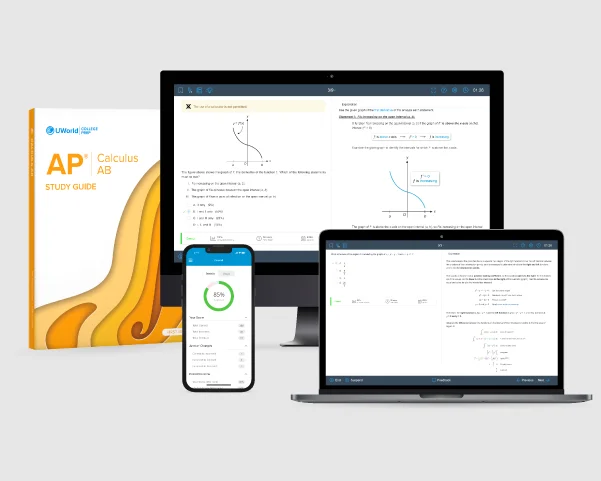
References
- AP Calculus AB. (n.d.). Collegeboard.org. Retrieved December 6, 2024, from https://apcentral.collegeboard.org/courses/ap-calculus-ab
- AP Calculus AB Course Overview. (2024). Collegeboard.org. Retrieved December 6, 2024, from https://apcentral.collegeboard.org/courses/ap-calculus-ab
- AP Calculus AB and BC Course and Exam Description. (2020). Collegeboard.org. Retrieved December 6, 2024, from https://apcentral.collegeboard.org/media/pdf/ap-calculus-ab-and-bc-course-and-exam-description.pdf
Related Topics
How to Answer AP Calculus AB FRQs
Learn how to deal with the FRQ section of AP Calculus AB. See our step-by-step instructions and a sample question to help you answer free-response questions quickly.
AP Calculus AB Study Plan & Tips
Whether you want to get a head start in the summer or wait until 2 weeks before the exam to prepare, we provide the tips you need to succeed.
Are you planning for AP Calculus AB? Get detailed information including what's on the exam, why you should take it, prerequisites, and more.
How to Self Study for AP Calculus AB
Learn how to self-study for AP Calculus AB like a pro! Follow this comprehensive plan filled with tips, tools, and resources for success.
Best AP Calculus AB Study Guide Comparison
Discover expert insights into Kaplan, Barron's, Princeton Review, and UWorld. Learn how each resource compares to help you choose the best fit.
Best AP Calculus AB Prep Course Comparison
Wondering which AP Calculus AB prep course is the best? Check out this detailed review to find the right course for your exam prep.



